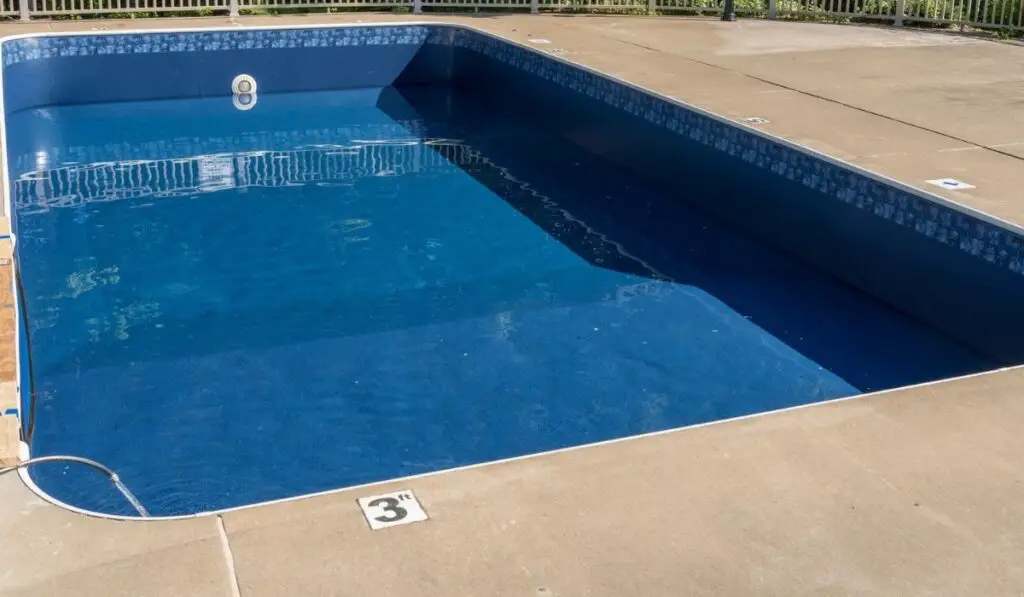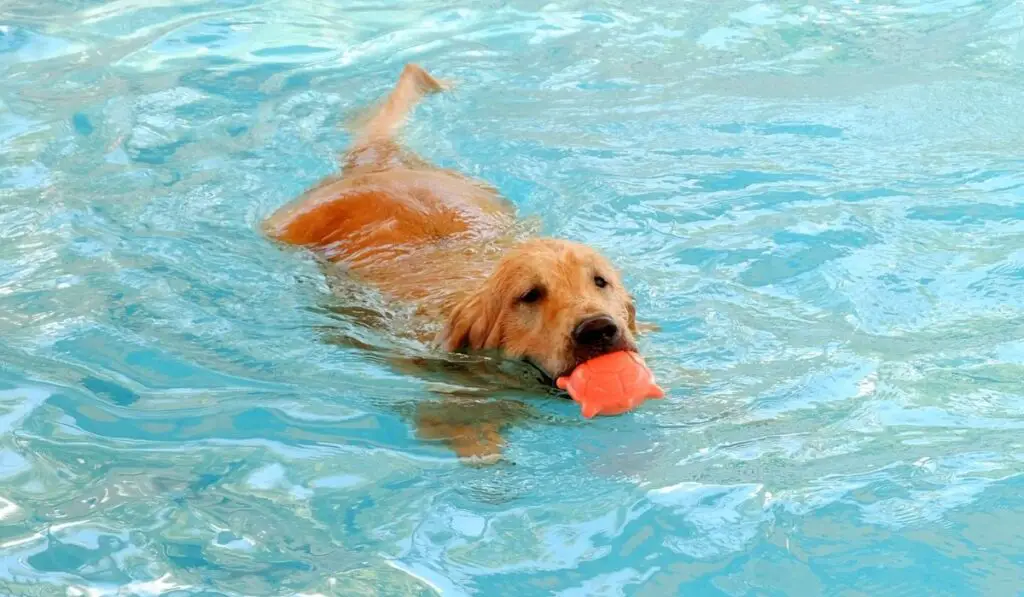From time to time, you may come across an entertaining video of a dog splashing about in a sparkling pool, and you may wonder if your dog might enjoy doing the same. However, before you let your dog take a swim, there’s an important question to ask: Can dogs swim in a vinyl liner pool?
It’s safe for your dog to swim in a vinyl liner pool. However, a problem could arise if your dog tries to claw their way out of the pool — it could shred the liner. Therefore, you’ll need to train your dog on how to get out of the pool correctly. This is a simple 2-step training process.
A swimming pool is a great spot for the whole family to relax and have fun — pets included. But you need to bear in mind that there are safety precautions when it comes to dogs and pools. That being said, let’s look at several key things you should know.
What Is Pool Liner Made From?

Pool liners are made from a very durable vinyl material known as colorized chlorinated PVC thermoplastic vinyl. They are quite easy to produce and affordable.
Can Dogs Swim in Liner Pools?
Yes, they can. However, vinyl liner pools and dogs aren’t exactly a great combo. Most of the liners out there are about 20-30 mils thick.
This makes it very easy for a dog to rip the liner as it tries to get out of the pool. If a vinyl pool liner gets ripped, you won’t need to drain the pool before getting it repaired.
Once you notice a breach in the vinyl liner, you should attend to it immediately. If there’s a leak in a pool liner, it can cause even more damage to the pool’s exterior. Getting it fixed as early as possible will ensure that you don’t end up spending a fortune on repairs.
Only a few minutes are needed to permanently fix such damage to the pool liner using a patch and a specialized adhesive.
How to Prevent Your Dog From Ripping the Pool Liner
In order to keep your liner in good condition, you’ll have to give your dog some training. During the training, have your dog wear a collar with a leash around its neck.
Then you can guide your dog around the pool and teach it the steps. This may require some patience; it can take time before your dog feels comfortable. Here are the steps to take:
Step One – Train on Getting In and Out of the Pool
- You probably need to go into the pool first before persuading your dog to follow suit. It’s normal if the dog shows signs of fear or reluctance around the pool. You can make your dog feel more comfortable and relaxed by being patient while giving it all the necessary encouragement you can.
- Once your dog summons up the courage to get into the pool, continue helping it to build more confidence and guide it back to the steps to leave the pool. You can praise your dog after it completes this task.
- Continue repeating the process until your dog gets used to it. Your dog may need some extra motivation; having a treat handy should do the trick.
- You’ll need to guide your dog in a small circle back to the steps.
- You can make the circle bigger as you continue the training. The essence of this is that your dog learns the process and can use it regardless of where it is in the pool.
- You should only stop the training when you’re certain that your dog has mastered the process without needing any guidance.
Step Two – Train on Getting Out Correctly Regardless of How They Got In
- The first stage is all about teaching your dog to get in and out of the pool. The next thing to teach your dog is how to leave the pool regardless of where it entered from.
- You need to use the leash here. While holding the leash, ensure that it’s not too tight. Have your dog take a walk by the pool and try to get it to jump in (this time, from the side and not the steps). At this point, your dog should have learned how to leave the pool using the steps.
- If you notice that your dog is trying to get out of the pool from the side where it entered, guide it gently towards the steps using the leash.
- Try out this method using different locations around the pool and continue the training until your dog gets used to it.
Which Types of Pools Are Safe for Dogs?
A lot of people take their pets into consideration before buying a pool. Let’s talk about the best pools for dogs, and by that we mean pools made of materials that dogs can’t scratch up as they try to fumble their way out.
- Fiberglass pools will always be on this list. That’s because they have strong, durable gel coats that can’t be torn by your dog’s claws. Fiberglass pools are also safe for dogs’ joints.
- Concrete pools are also a decent option. Your dog’s joints and claws, however, may not find the surface very friendly.
How to Make a Pool Dog-Friendly

Have a Fence Constructed Around Your Pool: One of the best safety measures you should follow is building a fence around your pool, especially if you have children or dogs around. Even if your dog has mastered the process of getting in and out of the pool without help, the fence is still good to have as a back-up.
Get a Dog Pool Ladder or Ramp: A dog pool ladder is a great option if you’re having trouble training your dog to use the steps. If you place a dog pool ladder in your pool, it gives your dog an extra way of leaving the pool safely. Consider this innovative dog pool exit ramp (on Amazon).
Make Sure Your Pool Is Saltwater: This is not only for humans. Pools that are saltwater are more friendly for dogs as well. Nowadays, a lot of pools use the saltwater option instead of the traditional chlorine method. For the same reason this is better for people (less eye stinging, less damage to hair, etc.) it’s better for pups too!
Have a Fiberglass Pool Installed: Another step you can take is installing a fiberglass pool. It’s very difficult for a dog to damage a fiberglass pool.
